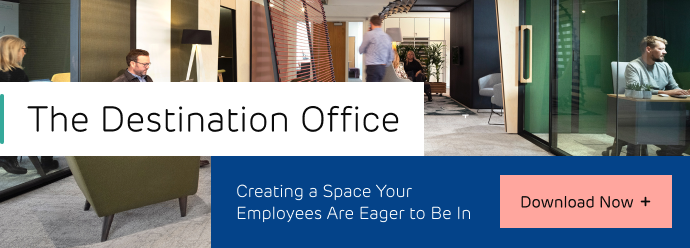Welcome to the office of the future - the 'destination office.' More than just a physical place to perform work tasks, a destination office is a vibrant, multifunctional hub.
Destination offices are far more than mere workspaces - they are dynamic ecosystems where work and lifestyle converge, inclusive and flexible spaces, and centres for learning and growth.
Let's delve into the destination office's defining features and why they are becoming a priority for forward-thinking organisations.
1. Wellbeing
At the heart of the destination office is the concept of wellbeing. These offices weave physical and mental health support into their very fabric, making wellbeing an intrinsic part of the workday rather than an afterthought.
The design of the destination office prioritises features that nurture physical health. Natural lighting, which is linked to improved mood and productivity, is maximised through open floor plans and glass walls. Ergonomic furniture and height adjustable desks are used to support good posture and reduce the strain of sedentary work.
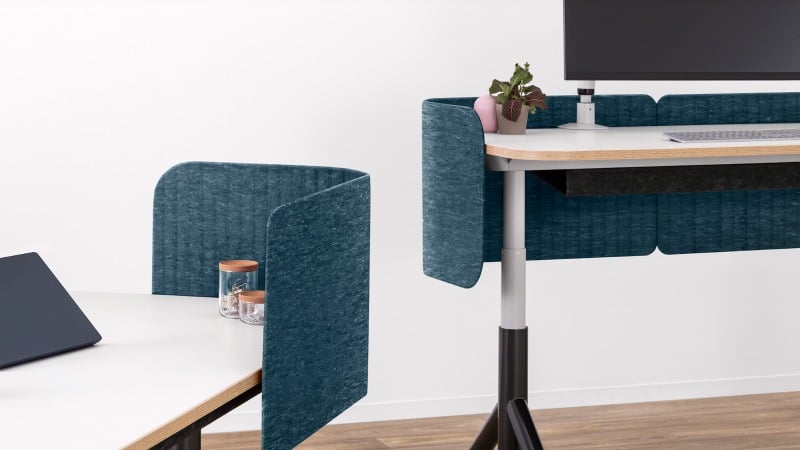
Equally important are the amenities provided to promote physical health. On-site gym facilities and fitness classes offer employees convenient ways to stay active. Some destination offices may also offer wellness rooms for relaxation or mindfulness practices, spaces dedicated to quiet reflection, or even nap pods for rejuvenating power naps.
The destination office also considers mental wellbeing. Green spaces, indoor plants, views of nature, and other biophilic design elements are known to reduce stress and boost mood. Artwork and aesthetic touches contribute to a stimulating and pleasant environment, which can boost morale and foster a sense of belonging.
Furthermore, destination offices often provide spaces for personal development and hobbies, promoting a balanced lifestyle that values both employees' interests and work contributions. These could range from libraries or quiet reading corners to game rooms, music rooms, or even maker spaces for creative pursuits.
By making wellbeing a central part of the work experience, organisations create an environment where employees can thrive personally and professionally, fostering a more engaged, productive, and loyal workforce.
2. Sustainability
Destination offices are embodiments of eco-consciousness. A reflection of the growing global consciousness about the health of our planet, these offices go beyond lip service to sustainability, making it an integral part of their identity.
At the design phase, the destination office prioritises the use of sustainable materials, opting for locally sourced and recycled components whenever possible. Energy efficiency is considered at every turn, with choices such as LED lighting, high-efficiency HVAC systems, and even renewable energy sources like solar panels or wind turbines.
The architectural design often focuses on maximising natural light and improving insulation, reducing the need for artificial lighting and excessive heating or cooling.
Furniture is also chosen with sustainability in mind, using the principles of the circular economy: selecting pieces made from recycled or recyclable materials designed for longevity and durability.
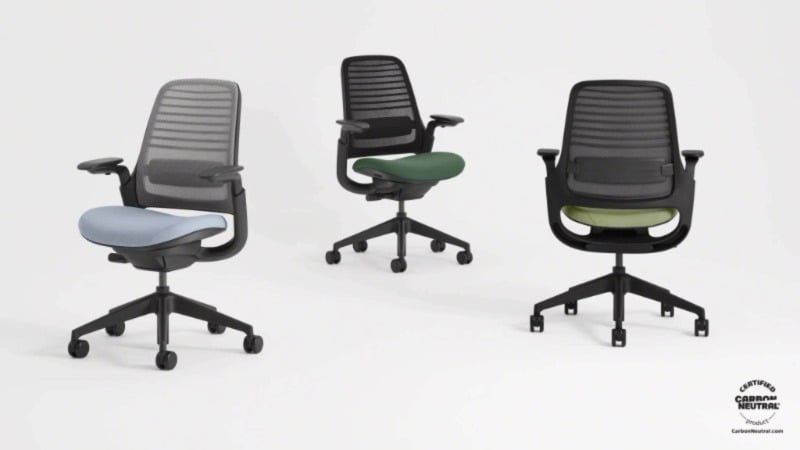
Destination offices also adopt sustainable operational practices like waste reduction and recycling programmes and initiatives to encourage eco-friendly commuting, such as bike racks or electric vehicle charging stations. The inclusion of green spaces, both indoor and outdoor, not only contributes to employee wellbeing but also supports biodiversity and improves air quality.
They may even go further by pursuing sustainability certifications such as BREEAM, LEED, or SKA. These certifications, awarded by independent bodies, validate the office's commitment to environmental stewardship, demonstrating that they meet high standards for sustainability.
By embedding sustainability into their DNA, destination offices do more than reduce their environmental footprint. They demonstrate to employees, customers, and the community that they are part of the solution to environmental challenges, reinforcing their commitment to a greener future and aligning with the values of many of their stakeholders.
3. Amenities and services
Destination offices redefine the traditional workspace by not only being a place for work but also serving as a platform that caters to various lifestyle needs.
These offices go beyond the standard facilities to offer an array of amenities and services that make the office an appealing destination for employees.
- On-site cafes and restaurants provide fresh, nutritious meals - a step up from the vending machine snacks in traditional offices. Some destination offices even feature gourmet or specialised food services, adding a touch of luxury to the daily work routine.
- Wellness rooms offer employees a space to de-stress and recharge.
- Fitness facilities and yoga studios offer convenient options for employees to maintain their physical health without leaving the office.
- Childcare facilities enable employees with young children to balance their parenting responsibilities without worrying about commuting or nursery schedules.
- Concierge or on-site dry cleaning services can save time and reduce stress, allowing workers to focus on their work with peace of mind.
Beyond the practical benefits, these amenities and services enhance the work experience, creating an environment that supports employees' holistic needs.
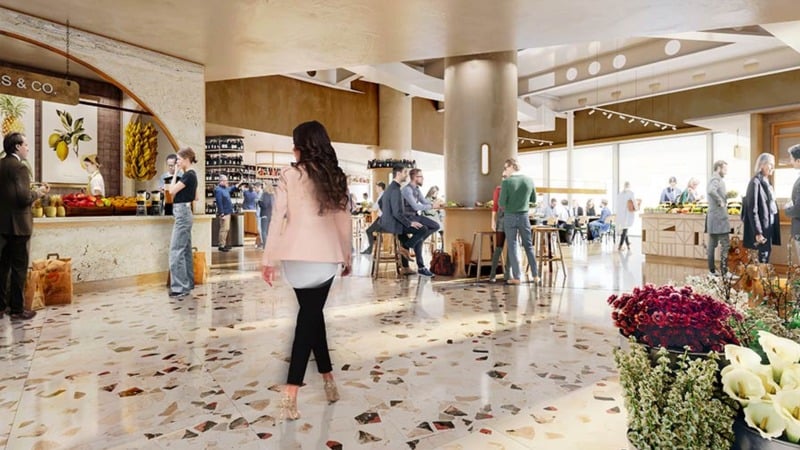
Image: The Market at 22 Bishopsgate
4. Tech integration
The role of technology in creating an effective workspace can't be underestimated. Destination offices are leading the way in tech integration, offering:
- Seamless connectivity - High-speed internet connectivity ensures smooth communication and fast data transfers. Whether it's a video conference with global teams, a large data file transfer, or simply browsing the web, the high-speed internet ensures a frictionless online experience.
- Smart office systems - Smart lighting and temperature control systems enable employees to adjust their environment according to their comfort levels. Desks or meeting rooms can be booked with a few clicks or swipes on a device, promoting a flexible and efficient use of space.
- Collaborative tools - Digital whiteboards, team messaging apps and project management tools are integrated into the work environment, enabling teams to work together effortlessly, whether together or apart.
- Emerging technologies - Virtual reality for immersive meetings, AI for smart assistance or IoT devices for enhancing office operations are all possibilities in the destination office.
The power of technology in the destination office lies in its capacity to enhance employee experience, facilitate effective communication and promote productivity.
It's not just about fancy gadgets but about creating a high-tech sanctuary where work gets done efficiently, and employees feel connected, engaged and empowered.
5. Impressive design
Design and atmosphere are integral to the destination office's identity and purpose. The aim is to create a world within the office - where employees feel comfortable, inspired and ready to do their best work.
The design of the destination office goes beyond aesthetics - it creates a tangible atmosphere that impacts how employees feel and function within the workspace.
- Natural lighting and biophilic elements - Windows, skylights, and glass walls allow natural light to permeate the office, creating a brighter and more inviting atmosphere. Meanwhile, plants, green walls, and water features bring elements of the natural world into the workspace, offering visual relief and improving air quality.
- Inspiring aesthetics - Walls may be adorned with inspiring artwork or graphics that echo the company's culture and values. Furniture is chosen for functionality, comfort, and design appeal, adding character to the workspace. Even colour schemes are carefully considered, with studies suggesting that certain hues can influence mood and productivity.
- Attention to detail - Every detail in the destination office is intentional. The layout of the furniture and the placement of breakout spaces are meticulously planned to facilitate flow, encourage collaboration, and provide solitude when needed. Acoustic design is another key consideration, with materials and spaces designed to absorb sound and minimise distractions.
- Comfort and homeliness - Warmer colours, softer lighting and comfortable lounge areas make employees feel as relaxed as they are at home. Some offices may even include fully-equipped kitchens, showers, and relaxation areas, further blurring the line between home and office.
- Adaptive design - Modular furniture, movable walls and versatile spaces mean the office layout can easily be reconfigured to accommodate changing needs or preferences.
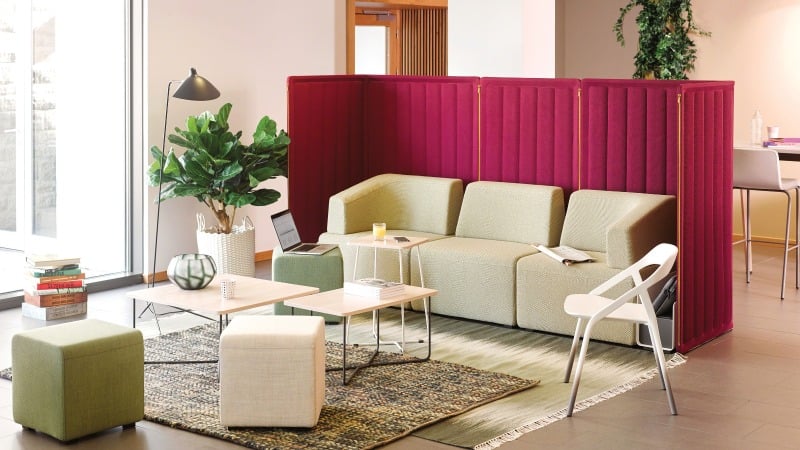
6. Flexibility
Flexibility is a cornerstone of the destination office. Accommodating diverse work styles, the office provides a variety of spaces for collaboration, individual work, socialising and learning.
Everything from quiet pods for focused work to meeting rooms for group discussions is available, supporting the different ways teams work.
- Collaborative spaces - Destination offices facilitate teamwork with designated areas for collaboration. Meeting rooms, project spaces, and open-plan areas are equipped with comfortable furniture and cutting-edge technology, fostering interaction and knowledge sharing.
- Focused workstations - Recognising the need for deep concentration, destination offices feature quiet areas where employees can work without distractions. Pods, booths, and partitioned workstations cater to different work styles and preferences.
- Social spaces - Social spaces are integral to the destination office. Lounges, communal kitchens, breakout areas, and other social amenities foster a sense of community and encourage informal learning and relationship-building among colleagues.
- Learning spaces - Learning spaces are equipped with the right tools and technology, facilitate engagement, collaboration, and exploration, underscoring the organisation's commitment to continuous learning and growth.
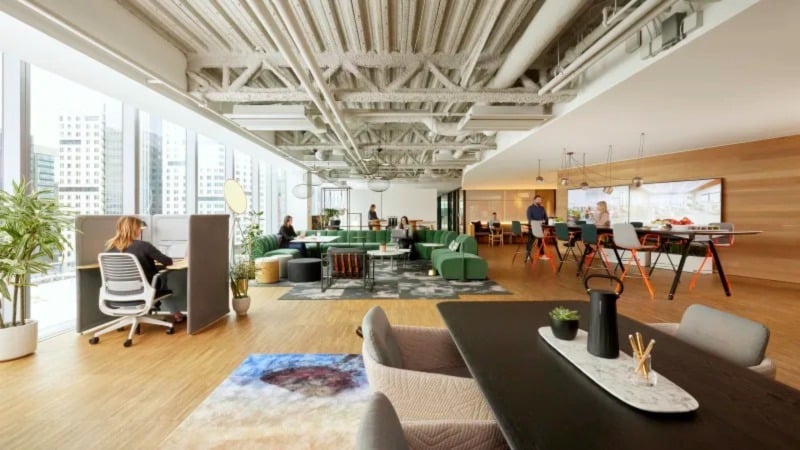
7. Inclusivity
Inclusive design is a critical feature of the destination office. It creates an environment that values, accommodates and respects the diverse range of individuals in the organisation.
Inclusivity extends beyond providing diverse spaces and into adopting universal design principles that ensure accessibility for all, regardless of age or ability. Some examples of inclusive design features include wheelchair-accessible workspaces, height adjustable desks, clear signage, and tactile surfaces.
Technology also plays a role, with software and hardware accommodating different abilities and needs. Inclusivity recognises and respects cultural diversity, as seen in art representing diverse cultures, spaces for prayer or meditation, and amenities that consider cultural sensitivities.
Conclusion
The destination office signifies a progressive approach to work-life integration. It transcends the traditional notion of an office being just a workspace.
But above all, the destination office is a space designed with the people at its heart, ensuring they are productive, healthy, engaged and fulfilled.
In the wake of a new work era, the destination office is more than just a place to work - it's a place to thrive, grow, and be part of a vibrant community.







